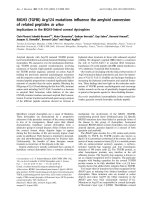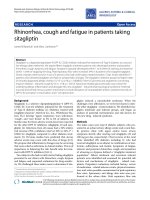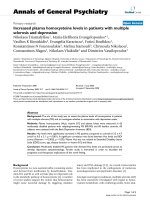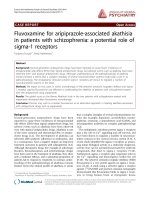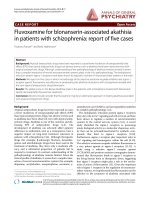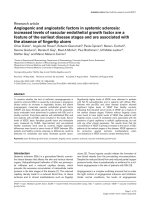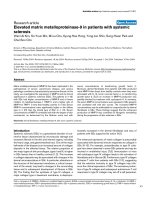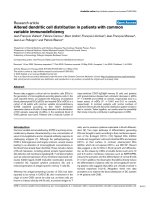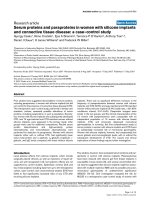Báo cáo y học: "Fluvoxamine for blonanserin-associated akathisia in patients with schizophrenia: report of five cases." pps
Bạn đang xem bản rút gọn của tài liệu. Xem và tải ngay bản đầy đủ của tài liệu tại đây (341.96 KB, 4 trang )
Furuse and Hashimoto Annals of General Psychiatry 2010, 9:17
/>Open Access
CASE REPORT
BioMed Central
© 2010 Furuse and Hashimoto; licensee BioMed Central Ltd. This is an Open Access article distributed under the terms of the Creative
Commons Attribution License ( which permits unrestricted use, distribution, and repro-
duction in any medium, provided the original work is properly cited.
Case report
Fluvoxamine for blonanserin-associated akathisia
in patients with schizophrenia: report of five cases
Tsutomu Furuse*
1
and Kenji Hashimoto
2
Abstract
Background: Atypical antipsychotic drugs have been reported to cause fewer incidences of extrapyramidal side
effects (EPS) than typical antipsychotic drugs, but adverse events such as akathisia have been observed even with
atypical antipsychotic drugs. Although understanding of the pathophysiology of akathisia remains limited, it seems
that a complex interaction of several neurotransmitter systems plays a role in its pathophysiology. The endoplasmic
reticulum protein sigma-1 receptors have been shown to regulate a number of neurotransmitter systems in the brain.
Methods: We report on five cases in which monotherapy of the selective serotonin reuptake inhibitor and sigma-1
receptor agonist fluvoxamine was effective in ameliorating the akathisia of patients with schizophrenia treated with
the new atypical antipsychotic drug blonanserin.
Results: The global score on the Barnes Akathisia Scale in five patients with schizophrenia treated with blonanserin
rapidly decreased after fluvoxamine treatment.
Conclusion: Doctors should consider that fluvoxamine may be an alternative approach in treating akathisia associated
with atypical antipsychotic drugs.
Background
Atypical antipsychotic drugs have been reported to cause
a fewer incidences of extrapyramidal side effects (EPS)
than typical antipsychotic drugs, but adverse events such
as akathisia have been observed even with atypical antip-
sychotic drugs. Akathisia is one of the common and dis-
tressing EPS of antipsychotic drugs [1,2]. The
development of akathisia can adversely affect patients'
adherence to medication, and, as a consequence, have a
negative impact on long-term treatment outcomes in
patients with schizophrenia [3,4]. Although therapeutic
drugs (for example, β-adrenergic blockers, benzodiaz-
epines, and anticholinergic drugs) have been used in the
treatment of akathisia, they show only a moderate effi-
cacy, and a substantial proportion of patients fail to
respond to treatment. In contrast, understanding of the
pathophysiology of akathisia remains limited. Given the
clinical profile of akathisia, it seems that a complex inter-
action of several neurotransmitter systems (for example,
dopamine, acetylcholine, norepinephrine, serotonin, γ-
aminobutyric acid (GABA), and neuropeptides) underlies
its complex pathophysiology [1,2].
The endoplasmic reticulum protein sigma-1 receptors
play a key role in Ca
2+
signaling and cell survival, and have
been shown to regulate a number of neurotransmitter
systems in the central nervous system [5-8]. A recent
study identified the sigma-1 receptors as possessing
innate biological activity as a molecular chaperone, activ-
ity that can be activated/inactivated by synthetic com-
pounds that bind to sigma-1 receptors [9,10].
Furthermore, sigma-1 receptors play important roles in
Ca
2+
signaling and bioenergetics within the cell [8-10].
The selective serotonin reuptake inhibitor fluvoxamine is
a very potent agonist at sigma-1 receptors [11,12]. A
study using a selective sigma-1 receptor agonist
[
11
C]SA4503 and positron emission tomography demon-
strated that fluvoxamine binds to sigma-1 receptors in
the living human brain at therapeutic doses, suggesting
that sigma-1 receptors might play a role in the mecha-
nism of action of fluvoxamine [13]. Given the important
role of sigma-1 receptors in the regulation of neurotrans-
mitter systems, we hypothesized that fluvoxamine may be
effective in the treatment of akathisia associated with
* Correspondence:
1
Department of Psychiatry, Asahikawa Red Cross Hospital, Asahikawa, Japan
Full list of author information is available at the end of the article
Furuse and Hashimoto Annals of General Psychiatry 2010, 9:17
/>Page 2 of 4
antipsychotic treatment. Very recently, we reported on
cases in which fluvoxamine was effective in treating arip-
iprazole-induced akathisia in patients with schizophre-
nia, suggesting that fluvoxamine would also be a potential
therapeutic drug for antipsychotic-induced akathisia [14].
Blonanserin (AD-5423; trade name Lonasen) is a new
atypical antipsychotic drug that has the properties of
both a serotonin 5-HT
2A
and a dopamine D
2
receptor
antagonist [15], and this drug has been used in Japan and
South Korea. The affinity of this drug at dopamine D
2
receptors is higher than that at serotonin 5-HT
2A
recep-
tors [15]. A randomized, double-blind, placebo-con-
trolled and haloperidol-controlled international
multicenter study demonstrated that blonanserin was
effective in the treatment of acute schizophrenia, and that
it had greater efficacy in negative symptoms compared
with placebo and haloperidol [16]. In addition, blonan-
serin was well tolerated and its safety profile compared
favorable with haloperidol, particularly with respect to
prolactin elevation and EPS frequency [16]. We have
experienced that treatment with blonanserin might cause
akathisia in some patients with schizophrenia, although
the data on blonanserin-associated akathisia have not yet
been published. Here we report five cases where fluvox-
amine was effective in treating blonanserin-associated
akathisia in patients with schizophrenia.
Case reports
Table 1 shows the characteristics of five patients with blo-
nanserin-associated akathisia.
Case 1
The patient was a 40-year-old man who met the Diagnos-
tic and Statistical Manual of Mental Disorders, fourth
edition (DSM-IV) criteria for schizophrenia. Onset of
schizophrenia occurred in his early twenties. The typical
antipsychotic drug haloperidol was administered for
some time. After he stopped the medication (haloperidol
2 mg) because of tremor, he jumped from a second floor
window due to delusions and hallucinations. He was then
admitted to the hospital's emergency medical center with
a right calcaneal fracture. His right leg joint was fixed in a
plastic cast, and he was admitted. Treatment with blo-
nanserin (8 mg) and flunitrazepam (2 mg, at night) was
initiated for auditory hallucination. At 1 week later, the
blonanserin was increased to 16 mg because his persecu-
tory delusions and auditory hallucinations persisted.
After the increase in dose (16 mg), the patient com-
plained of leg restlessness. His global score on the Barnes
Akathisia Scale [17] was 3 ('moderate akathisia'). Substan-
tial relief of akathisia was noted on the next day of fluvox-
amine (50 mg) treatment, at which point his global score
on the Barnes Akathisia Scale was 0. At 1 week later, the
dose of blonanserin was increased to 24 mg since he still
had psychotic symptoms. Fluvoxamine (50 mg) contin-
ued to be administered. He had no recurrence of the
akathisia. After 1 month, he was discharged home
because his psychotic symptoms were improved.
Case 2
The patient was a 48-year-old woman who met the DSM-
IV criteria for schizophrenia. The onset of schizophrenia
occurred in her late twenties, and 10 years previously she
had been admitted to a hospital emergency medical cen-
ter with delusions and hallucinations. She was treated for
this previous episode with haloperidol (6 mg), but she
had stopped the medication due to EPS. She was admit-
ted to the hospital emergency medical center with a
recurrence of psychosis, including delusions and halluci-
nations. Treatment with blonanserin (8 mg), flunitraze-
pam (2 mg, at night), and levomepromazine (50 mg) was
initiated. At 3 days later, the patient complained of leg
Table 1: Characteristics of five schizophrenic patients with blonanserin-associated akathisia.
Case Gender
(F/M)
Age
(years)
Dose of
blonanserin
Barnes AKS score
before
treatment
Barnes AKS score
after treatment
1 M 40 8-16 mg 3 0
2 F 48 8-24 mg 3 0
3 M 63 8 mg 2 0
4 M 36 8 mg 3 0
5 M 42 16-24 mg 3 0
Barnes AKS = Barnes Akathisia Scale.
Furuse and Hashimoto Annals of General Psychiatry 2010, 9:17
/>Page 3 of 4
restlessness. Her global score on the Barnes Akathisia
Scale [17] was 3. Substantial relief of akathisia was noted
on the next day of fluvoxamine (50 mg) treatment, at
which point her global score on the Barnes Akathisia
Scale was 0. The dose of blonanserin was increased to 24
mg due to an abnormal experience. Fluvoxamine (50 mg)
continued to be administered. After 3 weeks, she was dis-
charged home because she had no recurrence of the
akathisia.
Case 3
The patient was a 63-year-old man who met the DSM-IV
criteria for schizophrenia. The onset of schizophrenia
occurred in his early twenties. He had been treated with
olanzapine (10 mg) for the last 4 years, but he had a ten-
dency to stop the medication due to appetite and body
weight. He was admitted to the hospital due to delusions
and hallucinations at his older brother's funeral. Treat-
ment with blonanserin (8 mg) and etizolam (1 mg, at
night) was initiated for auditory hallucinations and delu-
sions. At 2 weeks later, the patient complained of leg rest-
lessness. His global score on the Barnes Akathisia Scale
[17] was 2. Substantial relief of akathisia was noted after
14 days of fluvoxamine (50 mg) treatment. His global
score on the Barnes Akathisia Scale was 0.
Case 4
The patient was a 36-year-old man who met the DSM-IV
criteria for schizophrenia. The onset of schizophrenia
occurred in his early twenties. He was admitted to the
hospital's emergency medical center with a cut to the
right of the neck from an unsuccessful suicide attempt.
Treatment with blonanserin (8 mg) and flunitrazepam (2
mg, at night) was initiated for auditory hallucinations. At
2 days later, the patient complained of leg restlessness.
His global score on the Barnes Akathisia Scale [17] was 3.
Substantial relief of akathisia was noted on the next day of
fluvoxamine (50 mg) treatment. His global score on the
Barnes Akathisia Scale was 0. Blonanserin (8 mg), fluvox-
amine (50 mg), and flunitrazapam (2 mg) continued to be
administered. After 2 weeks, he was discharged home
because he had recovered.
Case 5
The patient was a 42-year-old man who met the DSM-IV
criteria for schizophrenia. The onset of schizophrenia
occurred in his early twenties. He had been treated with
haloperidol (18 mg), chlorpromazine (150 mg), biperiden
(6 mg), and haloperidol decanoate (100 mg) for some
time. He tended to drink a lot of water due to mouth dry-
ness. He was admitted to the hospital's emergency medi-
cal center because he had fallen at home. He was
diagnosed with low sodium blood syndrome due to water
intoxication, and he was treated with intravenous nutri-
tion. After recovery, he was treated with blonanserin (16
mg) and flunitrazapam (2 mg, at night). At 2 days later,
the patient complained of leg restlessness after the
increase in blonanserin (24 mg). His global score on the
Barnes Akathisia Scale [17] was 3. Substantial relief of
akathisia was noted on the next day of fluvoxamine (50
mg) treatment, at which point his global score on the
Barnes Akathisia Scale was 0. After 1 week, he was dis-
charged home because she had no psychotic symptoms.
Discussion
To our knowledge, this is the first report demonstrating
that fluvoxamine is rapidly effective in the treatment of
blonanserin-induced akathisia in patients with schizo-
phrenia. Very recently, we reported that fluvoxamine is
also effective in the treatment of aripiprazole-induced
akathisia in patients with schizophrenia [14]. Neverthe-
less, a further randomized double-blind, placebo-con-
trolled study of fluvoxamine will be needed to confirm its
efficacy for the treatment of akathisia. From the present
study, it is unclear whether sigma-1 receptor agonism
appears to be irrelevant to the rapid antiakathitic action
of fluvoxamine. In order to confirm the role of sigma-1
receptors in the treatment of akathisia, a randomized
double-blind, placebo-controlled study of the selective
sigma-1 receptor agonist (for example, cutamesine
(SA4503)) in patients with antipsychotic-induced akath-
isia will be necessary.
Akathisia is a neurological side effect of antipsychotic
medications, which are used to treat various psychiatric
disorders such as schizophrenia and bipolar disorders
[1,2,4]. It seems that akathisia is simply a dopamine D
2
receptor blockade [1], although the precise mechanisms
underlying antipsychotic drug-induced akathisia are cur-
rently unclear. A number of neurotransmitter systems
play a role in the complex pathophysiology of akathisia
[1,2]. At present, it is unclear whether sigma-1 receptor
agonism is involved in the mechanism of the rapid anti-
akathitic action of fluvoxamine. Considering the impor-
tant role of sigma-1 receptors in the regulation of a
number of neurotransmitter systems [5-8], it is likely that
indirect modulation of several neurotransmitter systems
by sigma-1 receptor agonist may be involved in the mech-
anisms of this drug, although further detailed study will
be necessary [14].
Conclusions
These five cases suggest that fluvoxamine may serve as an
alternative option in the treatment of antipsychotic-
induced akathisia in patients with schizophrenia. Further
detailed randomized, double-blind studies of the selective
sigma-1 receptor agonist using larger samples should be
performed to clarify the role of sigma-1 receptors in the
efficacy of fluvoxamine for akathisia.
Furuse and Hashimoto Annals of General Psychiatry 2010, 9:17
/>Page 4 of 4
Consent
Written informed consent was obtained from all patients
in this case report after we explained the fact that fluvox-
amine use for akathisia is off label.
Competing interests
The authors declare that they have no competing interests.
Authors' contributions
TF contributed to the clinical and rating evaluations during the follow-up peri-
ods. KH conceived of the study and participated in its study and coordination.
All authors read and approved the final manuscript.
Author Details
1
Department of Psychiatry, Asahikawa Red Cross Hospital, Asahikawa, Japan
and
2
Division of Clinical Neuroscience, Chiba University Center for Forensic
Mental Health, Chiba, Japan
References
1. Iqbal N, Lambert T, Masand P: Akathisia: problem of history or concern
of today. CNS Spectr 2007, 12(Suppl 14):1-13.
2. Kane JM, Fleischhacker WW, Hansen L, Perlis R, Pikalov A, Assunção-
Talbott S: Akathisia: an updated review focusing on second-generation
antipsychotics. J Clin Psychiatry 2009, 70:627-643.
3. Kane JH: Extrapyramidal side effects are unacceptable. Eur
Neuropsychopharmacol 2001, 11(Suppl 4):S397-S403.
4. Kane JM, Barnes TR, Correll CU, Sachs G, Buckley P, Eudicone J, McQuade
R, Van Tran Q, Pikalov A, Assunção-Talbott S: Evaluation of akathisia in
patients with schizophrenia, schizoaffective disorder, or bipolar I
disorder: a post hoc analysis of pooled data from short- and long-term
aripiprazole trials. J Psychopharmacol 2010 in press.
5. Hayashi T, Su TP: Sigma-1 receptor ligands: potential in the treatment of
neuropsychiatric disorders. CNS Drugs 2004, 18:269-284.
6. Hashimoto K, Ishiwata K: Sigma receptor ligands: possible application as
therapeutic drugs and as radiopharmaceuticals. Curr Pham Des 2006,
12:3857-3876.
7. Maurice T, Su TP: The pharmacology of sigma-1 receptors. Pharmacol
Ther 2009, 124:195-206.
8. Ishikawa M, Hashimoto K: The role of sigma-1 receptors in the
pathophysiology of neuropsychiatric diseases. J Receptor Ligand
Channel Res 2010, 3:25-36.
9. Hayashi T, Su TP: Sigma-1 receptor chaperones at the ER-
mitochondrion interface regulate Ca
2+
signaling and cell survival. Cell
2007, 131:596-610.
10. Hayashi T, Stahl SM: The sigma-1 receptor and its role in the treatment
of mood disorders. Drugs Future 2009, 34:137-146.
11. Narita N, Hashimoto K, Tomitaka S, Minabe Y: Interactions of selective
serotonin reuptake inhibitors with subtypes of sigma receptors in rat
brain. Eur J Pharmacol 1996, 307:117-119.
12. Hashimoto K: Sigma-1 receptors and selective serotonin reuptake
inhibitors: clinical implications of their relationship. Cent Nerv Sys
Agents Med Chem 2009, 9:S197-204.
13. Ishikawa M, Ishiwata K, Ishii K, Kimura Y, Sakata M, Naganawa M, Oda K,
Miyatake R, Fujisaki M, Shimizu E, Shirayama Y, Iyo M, Hashimoto K: High
occupancy of sigma-1 receptors in the human brain after single oral
administration of fluvoxamine: a positron emission tomography study
using [
11
C]SA4503. Biol Psychiatry 2007, 62:878-883.
14. Furuse T, Hashimoto K: Fluvoxamine for aripiprazole-associated
akathisia in patients with schizophrenia: a potential role of sigma-1
receptors. Ann Gen Psychiatry 2010, 9:11.
15. Deeks ED, Keating GM: Blonanserin: a review of its use in the
management of schizophrenia. CNS Drugs 2010, 24:65-84.
16. Garcia E, Robert M, Peris F, Nakamura H, Sato N, Terazawa Y: The efficacy
and safety of blonanserin compared with haloperidol in acute-phase
schizophrenia: a randomized, double-blind, placebo-controlled,
multicentre study. CNS Drugs 2009, 23:615-625.
17. Barnes TR: A rating scale for drug-induced akathisia. Bri J Psychiatry
1989, 154:672-676.
doi: 10.1186/1744-859X-9-17
Cite this article as: Furuse and Hashimoto, Fluvoxamine for blonanserin-
associated akathisia in patients with schizophrenia: report of five cases
Annals of General Psychiatry 2010, 9:17
Received: 16 March 2010 Accepted: 24 April 2010
Published: 24 April 2010
This article is available from: 2010 Furuse and Hashimoto; licensee BioMed Central Ltd. This is an Open Access article distributed under the terms of the Creative Commons Attribution License ( ), which permits unrestricted use, distribution, and reproduction in any medium, provided the original work is properly cited.Annals of General Psychiatry 2010, 9:17
